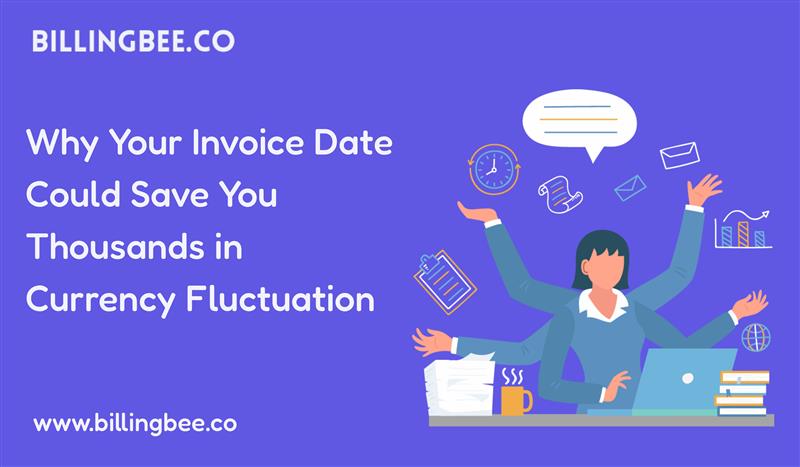Why Your Invoice Date Could Save You Thousands in Currency Fluctuation




For freelancers and small business owners working across borders, getting paid isn’t just about the amount—it’s also about the when. In a world where exchange rates can swing wildly from one week to the next, something as simple as your invoice date could mean the difference between profit and loss.
Let’s break down how strategic invoice timing can be your hidden financial defense—without needing a degree in economics or a Wall Street background.
The Global Work Landscape: Beautiful, but Volatile
You might be a graphic designer in India working for a startup in Germany. Or a SaaS consultant in South Africa billing a client in the US. The one thing you both likely have in common?
You’re getting paid in a different currency than the one you live in.
And that means every invoice you send has to travel across financial borders—exposed to shifting exchange rates along the way.
Currency Fluctuations Are Real, and They Hurt
Let’s say you invoice for €2,000 in January. At that time, the euro to INR rate was ₹90. So your payout equals ₹180,000. But by the time the money lands in your account in February, the rate has dropped to ₹88. That’s a ₹4,000 loss—simply due to timing.
And this isn't a rare case. Exchange rates can shift daily based on global events, market sentiment, and economic news. When you invoice internationally, you're always taking a small gamble—unless you play smart.
Timing Your Invoice: The Hidden Hedge
Most freelancers and small businesses send invoices the moment work is complete. While that seems efficient, it’s not always strategic.
Currency-aware professionals monitor exchange rates and time their invoicing accordingly.
Here’s how this works:
Let’s take a simple example.
Imagine you invoice a client in Europe for €2,000.
- If you had sent the invoice on January 3rd, when the euro to INR exchange rate was ₹90, you'd receive ₹180,000.
- But if you had waited and invoiced on January 10th, when the rate dropped to ₹88.50, you'd only get ₹177,000.
That’s a loss of ₹3,000, purely because of timing—even though the invoice amount in euros stayed the same.
Now imagine this happening month after month. Over time, these differences can silently eat into your income. Strategic timing may not eliminate currency risk entirely, but it can certainly reduce its impact.
Real-Life Example: Freelancer in Action
Meet Priya, a UX designer in Mumbai working with two EU clients. After noticing frequent variations in her payouts, she started tracking currency rates via alerts. When she saw a favorable trend—euro strengthening—she would invoice a day earlier or delay by a day to lock in a better conversion rate.
Over 6 months, Priya estimates she retained an additional ₹48,000—without changing her pricing or workload.
Tips to Make Strategic Invoicing Work for You
1. Track Exchange Rates
Use tools like XE, OANDA, or your banking app to monitor live rates and set alerts for favorable changes.
2. Invoice Early in a Strengthening Market
If your home currency is weakening against your client’s currency, invoicing sooner lets you lock in a higher return.
3. Delay Invoicing in Specific Cases
When trends show your home currency strengthening, it might make sense to wait a day or two—if your client doesn’t mind.
4. Understand Your Client’s Payment Cycle
Invoice timing is only helpful if it aligns with payment schedules. Factor in time zones, holidays, and internal processing delays.
5. Automate, But Stay in Control
Use invoice software that lets you prepare and schedule invoices, but make timing decisions manually when currency rates fluctuate.
This Isn’t About Timing the Market—It’s About Awareness
No one expects you to become a currency trader. But being aware of how your invoice date impacts your payout is a powerful, underused skill.
Even a 1% gain due to smart invoicing can boost your income significantly across the year.
And the best part? You’re not changing your work. You’re just sending your invoice on a smarter day.
Freelancers and SMBs Deserve to Think Like CFOs
Big corporations use hedging strategies to protect themselves from currency risk. But freelancers and small businesses? We have timing.
By mastering invoice timing, you take control of a small—but meaningful—aspect of your financial health.
Whether you’re a solopreneur or running a lean team, don’t underestimate this:
The date you click "Send Invoice" could quietly save—or cost—you thousands.
Let your invoice date work for you—not against you.
And if you’re looking for a tool that makes it easy to draft, hold, and send invoices at just the right time, well—there are smart platforms out there to help. Use your judgment, track your data, and invoice like a pro.